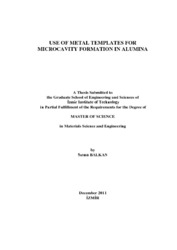Please use this identifier to cite or link to this item:
https://hdl.handle.net/11147/3179Full metadata record
| DC Field | Value | Language |
|---|---|---|
| dc.contributor.advisor | Akkurt, Sedat | en |
| dc.contributor.author | Balkan, Sırma | - |
| dc.date.accessioned | 2014-07-22T13:51:02Z | - |
| dc.date.available | 2014-07-22T13:51:02Z | - |
| dc.date.issued | 2011 | en |
| dc.identifier.uri | http://hdl.handle.net/11147/3179 | - |
| dc.description | Thesis (Master)--Izmir Institute of Technology, Materials Science and Engineering, Izmir, 2011 | en |
| dc.description | Includes bibliographical references (leaves: 63-67) | en |
| dc.description | Text in English; Abstract: Turkish and English | en |
| dc.description | xii, 67 leaves | en |
| dc.description.abstract | Alumina ceramics with microtunnels are produced by compressing submicron sized alumina powder and Ti, Cu or stainless steel wires in a metal die before firing the compacts at 1350oC for 4 hours. Diameters of wires ranged from 50 to 125 micrometers. Copper was found to completely melt and flow away from the compact leaving no trace of copper in alumina. Stainless steel diffused out into the alumina leaving few pores behind. Titanium, on the other hand, diffused into alumina at 20 to 30micrometers/hour and left plenty of Kirkendal porosity behind. The amount of porosity could have been increased further by applying intensive milling to the powder. But no milling was done in this study and hence a complete micro-tunnel was not obtained. The Kirkendal effect was observed to be effective in producing pores in the ceramic. Densification behavior of the ceramic was also investigated with a vertical dilatometer. Densities up to 93% were achieved in the ceramics. In some tests Ti metal plates were used as diffusion couples with alumina compacts. Similar diffusion behavior was observed with plates and wires. | en |
| dc.language.iso | en | en_US |
| dc.publisher | Izmir Institute of Technology | en |
| dc.rights | info:eu-repo/semantics/openAccess | en_US |
| dc.subject.lcsh | Porosity | en |
| dc.subject.lcsh | Ceramic materials | en |
| dc.subject.lcsh | Materials science | en |
| dc.subject.lcsh | Metals | en |
| dc.title | Use of metal templates for microcavity formation in alumina | en_US |
| dc.type | Master Thesis | en_US |
| dc.institutionauthor | Balkan, Sırma | - |
| dc.department | Thesis (Master)--İzmir Institute of Technology, Materials Science and Engineering | en_US |
| dc.relation.publicationcategory | Tez | en_US |
| item.grantfulltext | open | - |
| item.openairecristype | http://purl.org/coar/resource_type/c_18cf | - |
| item.cerifentitytype | Publications | - |
| item.openairetype | Master Thesis | - |
| item.languageiso639-1 | en | - |
| item.fulltext | With Fulltext | - |
| Appears in Collections: | Master Degree / Yüksek Lisans Tezleri | |
Files in This Item:
| File | Description | Size | Format | |
|---|---|---|---|---|
| T000998.pdf | MasterThesis | 5.84 MB | Adobe PDF |  View/Open |
CORE Recommender
Page view(s)
84
checked on Apr 22, 2024
Download(s)
52
checked on Apr 22, 2024
Google ScholarTM
Check
Items in GCRIS Repository are protected by copyright, with all rights reserved, unless otherwise indicated.